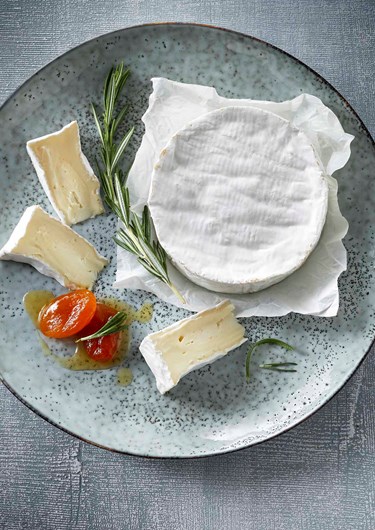
Camembert
What is Camembert?
Reminiscent of barren fields covered in snow, the bloomy rind of Camembert is unmistakeable. Equal in beauty, the pearly interior is smooth, soft and holds its consistency throughout. Kissed with earthy and sweet tones, this white mold cheese captivates with its slight hints of caramelized butter and foraged mushrooms. The aftertaste is rounded and somewhat tangy, with a pleasant and soft finish.
First introduced in northern France, Camembert is known to be slightly more intense in character than the closely related Brie. It is during production that the two really differ. Brie, with added cream, is seen as a triple crème cheese, unlike Camembert.
Sat beside walnuts, white wine or dressed in honey and plum chutney, Camembert will find a way to complement them all. As a starter or dessert, baked Camembert offers rich dipping for fruit, vegetables or biscuits. Serve Camembert at room temperature by removing it from refrigeration at least half an hour before serving.
How Camembert is made
The bloomy rind is more than just a stunning landscape. Balancing not only texture, it serves to provide a subtle contrast to the savory interior and helps give it its smooth consistency.
To ensure the cheese develops a rind worthy of a Camembert, it is mixed with a yeast culture during the coagulation. This is done before the milk is curdled, allowing the culture to spread and develop. Once the milk has formed a curd, it is cut and poured into molds, drained of whey and set to brine. Brining prevents any unwanted mold, while also providing flavor. The cheese is then arranged on shelves and turned regularly, ensuring that the mold grows evenly from the inside out, while also making the center creamy. Aging takes at least four weeks, resulting in a smooth and slightly firm texture. As the cheese ripens, it becomes softer and stronger in taste.
Depending on the type, Camembert can be made from either pasteurized or raw milk. With no fillers or artificial preservatives, the cheese is unadulterated and gluten free, though the addition of animal rennet makes it unsuitable for vegetarians.
Substitutes for Camembert
When choosing a replacement for Camembert, white mold cheeses with soft textures work well. It ultimately comes down to personal preference but picking a similar cheese for a dish or cheese board always pays off in the end.
A milder, softer take on white mold cheeses, Brie shares many similarities with Camembert. It is less earthy, and the flavors are subtle and mild, with hints of butter and fresh mushrooms. When young, the interior is slightly firm, slowly softening with age.
Our Double Crème White features a thin rind and creamy insides. The flavors are mild with notes of butter and hazelnut. Great on its own or paired with grapes, nuts and white wine.
Curious about the world of cheese? Here's everything you need to know about how to store, serve and cut cheese!







